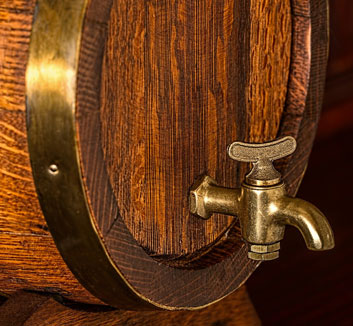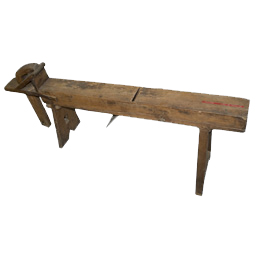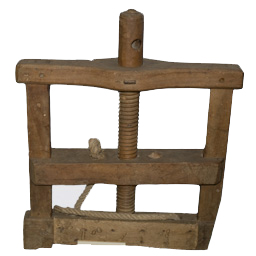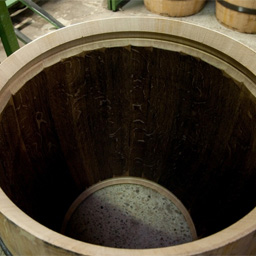
A doloire
 The barrel making is an industry that produces wooden containers that can hold liquids such as wine or solids such as seeds, cereals, etc. Among the products: vats (for fermentation), casks (very large capacity barrels), kegs, barrels and casks, and small containers such as drums (small barrels) or basins, etc.
The barrel making is an industry that produces wooden containers that can hold liquids such as wine or solids such as seeds, cereals, etc. Among the products: vats (for fermentation), casks (very large capacity barrels), kegs, barrels and casks, and small containers such as drums (small barrels) or basins, etc.
The wood used to make a barrel must be strong, flexible and easy to split. Its tannin level must also be favourable to the initial fining of wines (a clarification process). These qualities are found in the oak, when selecting the heartwood. The wood is left to dry in the open air for 2 or 3 years. This allows the tannin to drain away and the aromatic profile to sharpen. The barrel maker can also use another type of wood for the hoops. If they are not made of metal, they are usually made of chestnut.
 From the trunk of the tree, the barrel maker extracts merrains: a wedge-shaped piece. These pieces are then refined with a doloire and the heartwood and sapwood are removed. The result is staves, rectangular sections representing 1/3 of the merrain. They are used to make the shell of the barrel and the pieces that close its ends. The staves for the manufacture of barrels containing dry goods can be sawn regardless of the wood fibres. However, for liquids, they must be cut as close as possible to the direction of the wood to ensure impermeability and a certain resistance to the pressures that the barrel will be subjected to.
From the trunk of the tree, the barrel maker extracts merrains: a wedge-shaped piece. These pieces are then refined with a doloire and the heartwood and sapwood are removed. The result is staves, rectangular sections representing 1/3 of the merrain. They are used to make the shell of the barrel and the pieces that close its ends. The staves for the manufacture of barrels containing dry goods can be sawn regardless of the wood fibres. However, for liquids, they must be cut as close as possible to the direction of the wood to ensure impermeability and a certain resistance to the pressures that the barrel will be subjected to.
Once the staves are cut, they are joined to the router. This step creates edges to make them fit together during the assembling process.
 LAYING THE HOOPS
LAYING THE HOOPS The lip can now be dug out. It is a slot in the inner part of the barrel and at each end of it. It allows for the base of the barrel to be attached. These slots are dug with a chisel and the hoops are then loosened to make space for the base to slip through. During this process, forceps are used to hold the staves in place.
The lip can now be dug out. It is a slot in the inner part of the barrel and at each end of it. It allows for the base of the barrel to be attached. These slots are dug with a chisel and the hoops are then loosened to make space for the base to slip through. During this process, forceps are used to hold the staves in place.